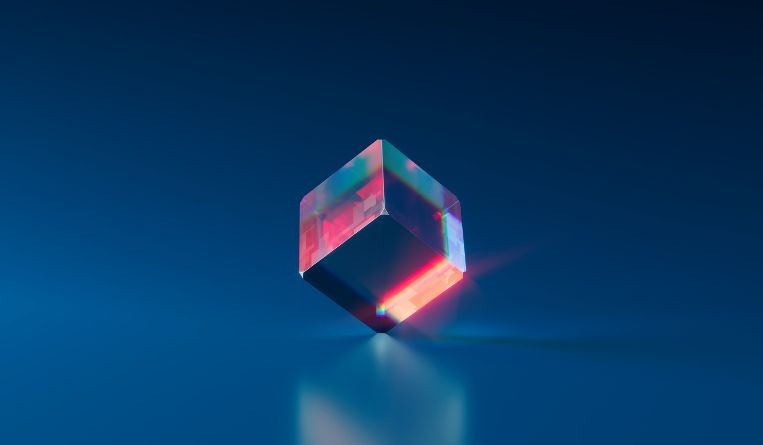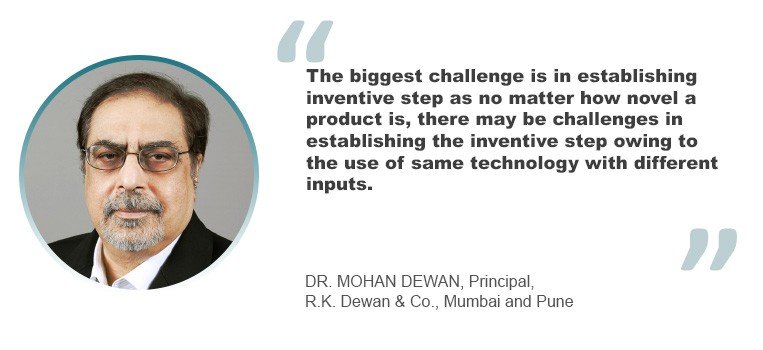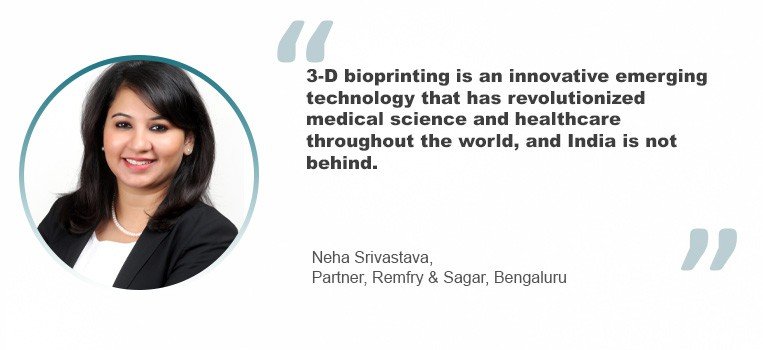3-D Bioprinting: Patentability challenges in India
31 July 2022

Three-dimensional bioprinting is a form of additive manufacturing. But instead of using typical 3-D printing materials such as plastic and metal, 3-D bioprinting makes use of cells, biopolymer gels and other carriers and biomaterials to create anything in the biological domain. This includes multi-layered skin, bone, vascular grafts, tracheal splints, cardiovascular tissue, parts of the alimentary canal and others.
Not only does 3-D bioprinting recreate these biological components structurally, it also mimics their functionality.
Thus, 3-D bioprinting, with its ability to produce more physiologically relevant functional results than those coming out of the in vitro 2-D model, may be applied to regenerative medicine, drug discovery, testing and development and 3-D cell culture.
The process, which involves layer-by-layer printing, has three steps.
The first is the pre-bioprinting stage. In this step, a 3-D model of a structure from a CT or MRI scan and a computer-generated design (CAD) file or the like to serve as the blueprint are obtained. And then the biomaterials to be used, called “bioink,” are prepared.
The next step is bioprinting, where tissues and organs are printed using a bioprinter.
The final step is post-bioprinting which involves stabilization and growth of the bioprinted structure.
In India, 3-D bioprinting is a patentable technology.
The subject matter claimed may be directed to pre-printing material such as bioink, processes including those for the preparation of the bioink compositions and manufacture of the bioprinted product, and of course the products of 3-D bioprinting themselves. Bioprinters, other devices, systems and 3-D bioprinting software applications are also patentable.
“Further, mere use, new medical use and method of treatment are not allowable in India. That aside, both product and processes can be patented provided that they qualify the triple test of novelty, inventive step and industrial application,” said Neha Srivastava, a partner at Remfry & Sagar in Bengaluru.
“In this regard, the biggest challenge is in establishing inventive step as no matter how novel a product is, there may be challenges in establishing the inventive step owing to the use of same technology with different inputs,” said Mohan R. Dewan, advocate and principal at R.K. Dewan & Co. in Mumbai and Pune. “Therefore, it may be argued that the novel product is an outcome of a known process with alterations only in the input materials, therefore, obvious as there is no substantial modification in known process.”
The challenge for patent applicants does not stop here. Other obstacles have to be hurdled, foremost of which are those arising from Section 3 of the Indian Patents Act, 1970.
Section 3(b) is against any invention contrary to the public order and morality or which causes serious prejudice to human, animal or plant life or health and the environment.
The morality aspect covers bioprinted construct using pluripotent stem cells or embryonic stem cells. This is anchored on the premise that commercial utilization and destruction of embryos were part of the initiative.
“Therefore, until the benevolence of this technology is firmly established, objection under this section may be expected,” said Dewan.
Section 3(c) bars any invention that is of natural origin.
“Said natural origin is determined by alterations of constitution of biological infrastructure, not merely by manufacturing the same natural material ex situ in laboratory environment, therefore, in case all the input material are of natural origin, then this provision may be a deterrent,” Dewan explained.
“Section 3(c) excludes patentability of naturally occurring substances; and the guidelines issued by the Indian Patent Office further emphasize that the substances should not be ‘directly isolated from nature.’ Therefore, any bioprinted component or product should be distinguishable over the naturally occurring form through some non-natural characteristics,” Srivastava added.
On the other hand, Section 3(d) bars the mere discovery of a new form of a known substance which does not result in the enhancement of the known efficacy of that substance or the mere discovery of any new property or new use for a known substance or of the mere use of a known process, machine or apparatus unless such known process results in a new product or employs at least one new reactant. This, therefore, serves as an add on to the inventive step requirement.
“As 3-D bioprinting would use the same technology for any novel output, objection under Section 3(d) may be slapped against any invention comprising 3-D bioprinting. In case the output is a combination of different input materials and identity of said inputs are not admixed to the core, then objection under Section 3(e) may be raised due to having a substance obtained by a mere admixture resulting only in the aggregation of the properties of the components thereof or a process for producing such substance,” said Dewan.
As for Section 3(i), Dewan said: “If the subject matter of the invention constitutes directly to a method of treatment and/or diagnosis or any process for enhancing the economic aspects of the livestock, objection under Section 3(i) may be expected barring any process for the medicinal, surgical, curative, prophylactic or other treatment of human beings or any process for a similar treatment of animals to render them free of disease or to increase their economic value or that of their products.”
Meanwhile, Section 3(j) bars plants and animals in whole or any part thereof other than microorganisms but including seeds, varieties and species and essentially biological processes, for production or propagation of plants and animals. This exclusion has also been extended to bioengineered/genetically modified forms of such parts.
“From the Indian perspective, the naturally occurring patient’s cells used in creating 3-D printed tissues or organs automatically come within the purview of ‘any part thereof’ under Section 3(j),” said Srivastava. “Further, although arguable, the growth and aggregation of such cells to form the bioprinted model may be considered as mechanisms inherent to the essentially biological processes involved therein, thus barring patentability of 3-D-printed tissues or organs. Nonetheless, it may still be possible to claim the overall method of bioprinting which can certainly be shown to include an act of human intervention.”
She added that overall, while patent applicants may be able to acquire patents by suitably addressing the requirements and those under Sections 3(d) and 3(e), the exclusions under Sections 3(b), 3(c) and 3(j) pose significant problems in obtaining protection for 3-D bioprinted constructs or products or pre-printing material such as cells/biomaterial per se used as seed.
“All these objections are anticipatory,” Dewan stressed, “and may only be predicted after an in depth look at the invention disclosure.”
When the biological material to be used in the invention is acquired from India, the patent applicant is required to seek prior approval from the National Biodiversity Authority (NBA). The Patents Act mandates the furnishing of such prior permission or approval to the IPO before a patent is granted. With this requirement, another problem emerges.
“The procedure for obtaining NBA approval is often long and cumbersome and causes inordinate delays in the grant of patents,” revealed Srivastava. “Besides, patent applicants suffer due to the lack of awareness and un-intended contravention of the biological diversity statute through activities undertaken before obtaining NBA approval, as well as unreasonably harsh penal provisions.”
IP ownership itself and liability issues may also present problems.
“Under Indian law, Section 48 confers exclusive rights to the patent owner to prevent third parties, who do not have his consent, from making, using, offering for sale, selling or importing for those purposes the patented product or process for obtaining that product, in India. Since the technology essentially includes CAD files, bioink and bioprinter and CAD files can be easily shared online, any person having the access to same may freely use, sell and distribute the technology without the consent and knowledge of the patent owner,” Srivastava pointed out.
Also, it would be difficult to separate consumers from manufacturers. This is because consumers can themselves manufacture the 3-D bioproducts. When the patent is infringed, certain questions have to be answered, such as: Who would be liable for infringement, the owner/operator of the 3-D bioprinter or the owner of the CAD file? Does downloading the CAD file for the purpose of producing the drug or bioprinted product amount to import? Is the CAD file, in itself, a drug or a medical device?
Patentability aside, there are the moral and ethical challenges as well as 3-D bioprinting involves live materials that are the building blocks of our biological world.

Addressing patentability challenges of 3-D bioprinting
To establish inventive step, Dewan said the need of the hour is to develop a process optimization leading to standardization of protocol, specific to each output, subjected to the objects of the invention.
This may also work in addressing the challenge of Section 3(d).
For Section 3(e), he said the dissolution of individual identity of the component(s) in the final output is the best solution.
“It may be noted further that generally the tenets of Sections 3(d) and 3(e) are mutually agnostic; therefore, either of the defenses should suffice,” Dewan said.
Section 3(c) may be bypassed in case a potent “human hand” could be shown as for 3-D bioprinting. “It may not be possible to show engineering at the genetic or protein level,” he explained.
With regard to Section 3(i), he said care must be taken that no procedure for organ transplant or the likes are claimed. Furthermore, the claim of the invention should only constitute the product and process of manufacturing said product. Details about the modus operandi of the product in vivo or the method of transplanting said product in human or animal system should not be provided.
Srivastava offers additional advice:
“It is also imperative that the structural and functional differences of the product over the naturally occurring counterpart are clearly brought out in the description, and the advantages or technical advancement is demonstrated through experimental data. Additional post-filing data submitted in the form of an affidavit may be acceptable, provided features relied on were at least plausible at the filing date,” she said.
She stressed that due diligence must be exercised in obtaining the prior NBA approval, wherever applicable. Due diligence is also important in disclosing the source and geographical origin of biological material used in the invention.
Where bioprinted products derived from pluripotent stem cells including embryonic stem cells are concerned, Srivastava said specification should be drafted clearly to explain that use of such stem cells does not involve destruction of human embryo.
“In case of pending cases where specification is not clear in this respect, a suitable explanation may be provided either in affidavit or submission or a statement thereto may be incorporated in the description,” she added.

The state of 3-D bioprinting in India
According to Dewan, objections to patentability of a particular technology may be directly proportional to the interest on that technology.
How is interest in 3-D bioprinting shaping up in India?
Apparently, 3-D bioprinting is a huge thing in the country which is regarded as a global centre for manufacturing and R&D.
“Yes, it is certainly a huge issue as 3-D bioprinting is an innovative emerging technology that has revolutionized medical science and healthcare throughout the world,” said Srivastava, “and India is not behind.”
India is among the top 12 destinations globally for biotechnology. The country is also projected to contribute 19 percent to the worldwide biotechnology market by 2025.
On February 24, 2022, the government launched its National Strategy on Additive Manufacturing (AM), rolling out a comprehensive 3-D printing policy.
The policy was designed to enable India to contribute 5 percent to the global additive manufacturing market by 2025, establish it as a global hub for additive manufacturing, and develop and safeguard its additive manufacturing intellectual property.
The policy also covers 3-D bioprinting of surgical models like organ, vasculature, implants, tumour models and disease models. In addition, it is targeting the creation of 50 India-specific technologies for material, machine, process and software; 100 new startups; 500 new products; and a pool of skilled manpower.
Previously, a dedicated 3-D bioprinting facility for artificial organs opened at the Andhra Pradesh MedTech Zone (AMTZ) in southeastern India. Situated in the city of Visakhapatnam in Andhra Pradesh, AMTZ is India’s first medical device park. It houses common manufacturing and scientific facilities such as laboratories, warehousing and testing centres.
Activities are not confined to the medical device park, however. Elsewhere, from Bengaluru to Trivandrum to New Delhi, from startups to scientific institutes, 3-D bioprinting projects are continuing unabated.
Among these is the Indian Institute of Science where scientists have come up with bioprinted silk fibroin (SF) scaffolds for bone tissue regeneration using silk fibroin from silkworm.
The Indian Institute of Technology Bombay and Sree Chitra Tirunal Institute for Medical Sciences and Technology in Thiruvananthapuram, Kerala, on India’s southwest coast are also at the forefront of efforts among India’s scientific institutes.
Also deep in its 3-D bioprinting initiatives is the startup BioApp. The group has collaborated with the Massachusetts Institute of Technology and Harvard University to manufacture advanced equipment and technology for 3-D bioprinting.
Meanwhile, Next Big Innovation Labs brandishes its flagship product, Innoskin, a 3-D bioprinted skin tissue for testing skin irritation and corrosion.
These are just some of the 3-D bioprinting activities happening in India.
Government support for the technology is growing, research funding has been increased, regulations and data requirements are less stringent compared to developed countries and demand is rising from the healthcare and cosmetic industries.
“Efforts have also been fuelled by incremental occurrences of organ failures recorded every year, huge gap between organ demand and availability, rising instances of chronic illnesses like diabetes and hypertension, and ability to offer ethical, cost-effective and faster alternative to drug testing in human and animal clinical trials,” said Srivastava.
Even Covid-19 has contributed to this uptrend, with human tissues and organs now being modelled. The objective: To study effects of SARS-CoV-2 and therapeutic agents on human body and for replacement.
According to Srivastava, it is important to have a sound patent system to ensure returns for the innovators and incentivize the cycle of advancement. This is especially so considering the effort, time and cost involved in bringing bioprinted products to the market.
“Since, the 3-D bioprinting industry is still at a nascent stage, considering how important IP rights and scientific progress is for the nation in this space, it would be interesting to see how the Indian jurisprudence develops around patenting of 3-D printed tissues and organs in the times to come,” she said.
- Espie Angelica A. de Leon






